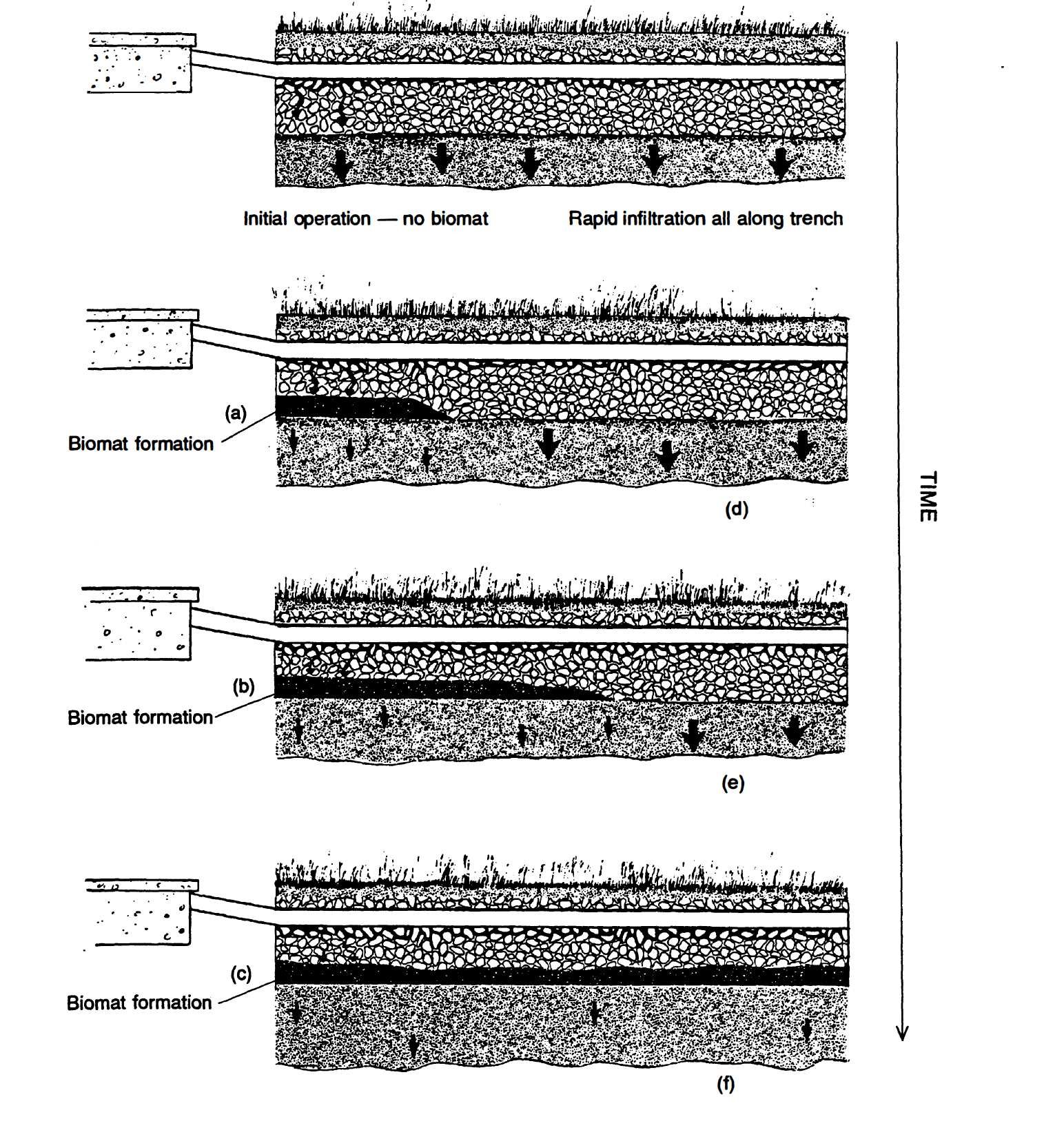Much of today's public health knowledge regarding on-site systems was obtained during the early part of this century. Until that time, many outbreaks of contagious diseases occurred because sources of disease ( drinking or coming into contact with contaminated water) were not yet known or understood. These contagious diseases are called water-borne diseases because they are spread by contaminated water. Other diseases were found to result when people came into contact with improperly disposed human wastes.
A basic principle learned in those early years was that to improve overall public health, sources of disease must be kept away from human contact. On-site systems use this principle by carrying human wastes deep into the soil and letting the soil absorb the wastewater so that the disease-causing organisms are in the soil, separated from humans. If on-site systems malfunction, the improperly treated and disposed wastewater becomes a potential source of disease and a genuine public health threat when humans come into contact with it.
Diseases carried in wastewater.
Improper disposal of human waste creates ideal conditions for outbreaks of many contagious diseases. Water-borne diseases include typhoid fever, cholera, dysentery, hepatitis, giardiasis, cryptosporidosis, hookworm, tapeworm, and other diseases that have plagued humankind since ancient times. Because we have developed proper means to treat and dispose of human wastes and wastewater, these previously common diseases no longer present a major problem.
How disease is spread.
From the public health point of view, there are two very dangerous types of onsite system failure. The first occurs when the wastewater does not infiltrate the ground. Instead, the wastewater ponds, or comes to the land's surface and forms a small pool or wet, mushy area. This unabsorbed wastewater may contain many disease-causing bacteria, viruses, and parasites.
There are three ways that humans could become sick when wastewater ponds in a treatment and disposal field.
1. Humans can come into contact with the pooled wastewater. Children are most likely to play in the pools or wet soil, but adults may have to walk through or work in the area. Once the wastewater is on the person's hands or body, the germs can spread to their mouth or nose where they are swallowed or inhaled.
2. Humans can drink contaminated water. Failing on-site systems can pollute wells, streams, rivers, and lakes, which may be used as water supplies. Wastewater from the pool can flow into a nearby stream and thereby contaminate the water bodies downstream.
3. Disease germs can be spread by insects or other animals to human food or drinking water. The animals that spread disease germs are called vectors. One of the best known vectors is the common housefly. It spreads disease by landing in or drinking pooled wastewater and then landing on food that humans later eat. The germs on the fly are then eaten by the humans.
A second type of on-site system failure occurs when an on-site system pollutes a well. This type of failure happens when the well is not properly constructed. In some cases, the on-site system may not be pooled wastewater on the surface, but the wastewater flows through cracks in the soil or underlying rock into the well.
If wastewater enters the well, people get sick by drinking water from the well. The on-site system or the well or both may have to be moved or rebuilt to ensure a clean supply of water.
Toxic chemicals.
Wastewater not only carries many diseases, it also contains chemicals that can cause poor health, cancer, or death. A range of information exists about the different chemicals found in the effluent from on-site systems.
Nitrate. One chemical, nitrate, has long been known to affect health, and we know a great deal about its origin and health effects. Nitrogen in wastewater is converted to nitrate by the bacteria in the septic tank and field during decomposition. The nitrate moves rapidly with the wastewater through the soil. If the wastewater gets into a drinking water well, the nitrate can be drunk by the site's residents or neighbors.
Infants younger than six. months are most susceptible to nitrate poisoning. Bacteria that live in the digestive tracts of newborn babies convert nitrate to nitrite. Nitrite then reacts with hemoglobin, which carries oxygen in blood, to form methemoglobin. Methemoglobin cannot carry oxygen, thus'the affected baby suffers oxygen deficiency. The resulting condition is referred to as methemoglobinemia, or "blue baby syndrome." Most reported cases of blue baby syndrome due to contaminated water have ocurred with greater than 40 mg/I nitrate-nitrogen.
The US EPA standard for nitrate is 10 mg/I as nitrogen in drinking water.
Artificial chemicals. Many artificial chemicals can be found in on-site wastewater effluent. Many chemicals are not "biodegradable" or broken down by bacteria in the septic tank and field. Because these chemicals are not broken down, they can flow into ground water or surface water and eventually into drinking water.
Because of the wide variety of artificial chemicals, it is difficult to say what types of problems the chemicals may cause. Some chemicals are toxic or poisonous, while others may cause cancer or other diseases.
Wastewater must be absorbed into the soil and have adequate contact time in the soil so that it does not spread disease germs or toxic chemicals. When the wastewater is held in the soil, and the soil is suitable for on-site wastewater treatment, neither humans nor animals can come into contact with it and it will not pollute streams or ground water. Thus, a properly operating on-site system protects public health.
On-site wastewater disposal can pose a threat to the environment. Presently, more than 50% of North Carolina housing units, representing about 3.5 million people, depend upon on-site wastewater disposal. Based on these figures, on-site systems distribute 360 million gallons of wastewater to the environment each day.
The large volume of wastewater being discharged into the environment can cause damage to both surface and ground water. Damage is caused by the way the wastewater is discharged in the environment and the type and amount of pollutants in the water.
Nonpoint source pollution.
Pollution from on-site systems is categorized as nonpoint source pollution. Nonpoint source pollution comes from activities that are spread over large areas ofland. Point source pollution, on the other hand, comes from a single point such as a pipe discharging industrial waste from a large factory.
Most nonpoint source pollution results from common activities and from land use. Examples of other nonpoint source pollution sources are:
fertilizer and pesticides from farming;
oil, grease and toxic metals from parking lots, roads, and automobiles;
sediment from bare land, construction sites, and newly developed areas; and
industrial and commercial chemicals from spills and leaks at industrial sites and commercial zones.
If on-site systems malfunction, the wastewater can contribute significant quantities of raw sewage and bacteria to surface and ground water. In addition, the wastewater from on-site systems contains certain pollutants, such as nitrate and phosphorus, which are not biodegradable in the on-site system but act as pollutants in water bodies. Thus, even systems that appear to be functioning properly can contribute to pollution of streams, lakes, marshes, or ground water.
Environmental impacts.
Pollutants in the wastewater affect animals, plants, and their habitats. Because onsite systems continually contribute huge amounts of wastewater to the environment, the long-term effects can be very serious. Some environmental impacts of wastewater are discussed below.
Nitrate and phosphorus from on-site systems can cause eutrophication, an overgrowth of algae, plants, and bacteria in water bodies. Often, eutrophication appears as algae blooms in streams, rivers, estuaries, or marshes, and even sounds and bays on the ocean. Overgrowth causes fish kills and ruins the habitat for many types of plants and animals. Eutrophication occurs more often where the water moves slowly, such as in lakes, bays, and slow-moving rivers.
In some areas, on-site systems are blamed for destroying shellfishing by releasing bacteria into the receiving water.
Wastewater from on-site systems can cause certain parts of a stream to become anaerobic, which means there is no oxygen in the water. Pollutants in the on-site wastewater serve as food for bacteria and certain types of anaerobic animals. The bacteria and animals grow very rapidly and use up all the oxygen in the stream. This lack of oxygen suffocates fish, other animals,· and plants.
Toxic and synthetic chemicals from on-site systems can enter the shallow ground water. This happens most often where the soil is sandy or the water table is very high. Under these conditions, the wastewater does not receive adequate treatment to biodegrade the pollutants in the wastewater.
Because so many on-site systems discharge so much wastewater, all on-site systems must be installed so that the wastewater receives the best treatment possible to protect the environment.
From the North Carolina Onsite Guidance Manual





